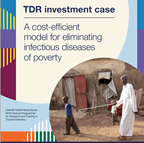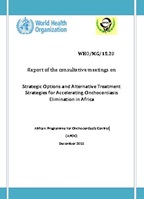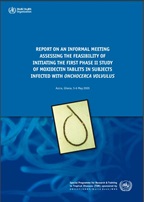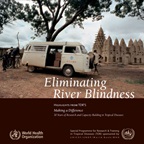
Onchocerciasis and lymphatic filariasis research
Onchocerciasis and lymphatic filariasis research
Onchocerciasis (River blindness)
Onchocerciasis is an eye and skin disease caused by the parasite Onchocerca volvulus. The symptoms, including itching, changes in the skin, visual impairment and even blindness, are caused by the body’s inflammatory response to dying O. volvulus microfilariae. The parasite is transmitted by blackflies of the genus Simulium. They breed in fast flowing rivers which has contributed to the name ‘river blindness’. More than 99% of affected people live in sub-Saharan Africa.
Lymphatic filariasis (Elephantiasis)
Lymphatic filariasis is caused by three different species of roundworms: Brugia malayi, Brugia timori and by Wuchereria bancrofti, which accounts for around 90% of infections. The adult parasites (macrofilariae) live in the lymphatic system. The inflammation this causes damages the lymphatic system which ultimately results in lymphoedema and hydrocele. Lymphoedema affects primarily the lower limbs and its advanced form has contributed to the name ‘elephantiasis’.
Background
TDR has a long history of research to support the control of onchocerciasis as the ‘research arm’ of the Onchocerciasis Control Programme in West Africa (OCP, 1974–2002) and the African Programme for Onchocerciasis Control (APOC, 1995-2015). TDR-managed studies demonstrated, for example, the safety and effectiveness of community-directed treatment with ivermectin (CDTI, the current control and elimination strategy) and that long-term CDTI can not only control onchocerciasis as a public health problem but may also allow to eliminate parasite transmission.
More recently, TDR funded and managed the clinical studies in Africa which provided the evidence that moxidectin reduces skin microfilariae levels in more people, to a larger extent and for longer than ivermectin. These data supported regulatory approval of moxidectin for treatment of O. volvulus infected people ≥12 years by the Food and Drug Administration of the United States of America.
Currently, TDR supports:
- Further research on moxidectin, a new drug for onchocerciasis and potentially other NTDs. TDR provides scientific and technical advice on additional studies required to support decisions on incorporating moxidectin into WHO guidelines and country policies for onchocerciasis elimination, to evaluate the efficacy of moxidectin for other diseases of poverty and to develop a paediatric formulation.
- Research for tools to estimate and minimize the risk of resurgence after mass drug administration for onchocerciasis and lymphatic filariasis has been stopped, monitor decline of the reproductively active O. volvulus population and monitor O. volvulus response to ivermectin.
Our work
Related links
WHO and TDR publications
Adaptation to social, environmental and climate change impacts on vector-borne diseases
SummaryThis is the report from an informal expert consultation on “Adaptation to Social, Environmental and Climate Change Impacts on Vector-Borne...
Research priorities for helminth infections
SummaryThis report presents an evaluation of current research and challenges in controlling the helminthiases of public health importance, including onchocerciasis,...
Guidelines for stopping mass drug administration and verifying elimination of human onchocerciasis. Criteria...
Following the publication of Guidelines on certification of elimination of human onchocerciasis in 2001 by the World Health Organization (WHO), these...
------------------ ARCHIVED PUBLICATION This publication contains guidance that is out of date. ------------------ The Global Programme to Eliminate Lymphatic...

TDR investment case
TDR, the Special Programme for Research and Training in Tropical Diseases, is a global programme of scientific collaboration that helps facilitate, support...

Report of the consultative meetings on Strategic Options and Alternative Treatment Strategies for Accelerating...
APOC conducted a series of consultative workshops with the national control programme managers, representatives of NGDOs and other organisations involved...

Report on an informal meeting assessing the feasibility of initiating the first Phase II study of moxidectin...
WHO convened an informal meeting in Accra, Ghana to assess the feasibility of initiating the first study of moxidectin tablets in subjects infected with...

Eliminating River Blindness
The global effort to eliminate onchocerciasis (river blindness) is driven by close collaboration between research and public health agencies. Researchers...
For more information, contact:
Dr Annette Kuesel

